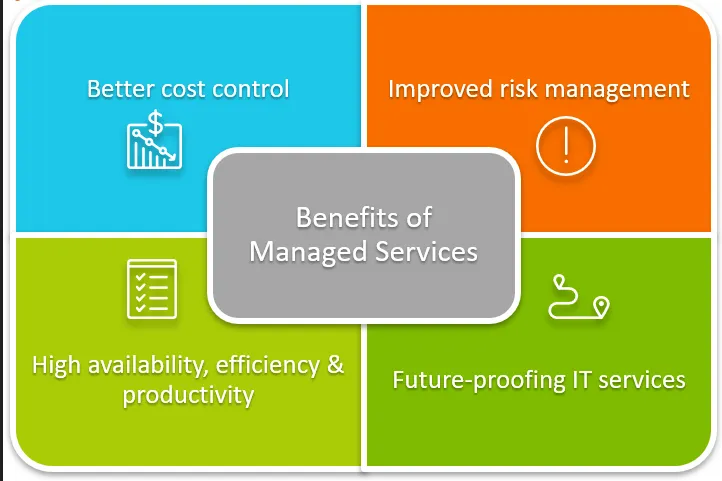Welcome to the era of automation, where technology is reshaping the very foundation of managed services. Labor-intensive manual tasks are being replaced by streamlined processes, accelerating workflow and eliminating costly delays. Automation is not just making tasks easier; it’s transforming businesses.

Fig. 1: Automation in Managed Services
Image Credit: Pyramid Solutions
Join us as we explore how automation is shaping managed services, driving businesses towards higher efficiency, customer satisfaction, and profitability. Discover how this transformative technology is revolutionizing traditional operating models and propelling MSPs into a future where success is defined by embracing the limitless potential of automation. Get ready to unlock the true power of automation and transform your managed services to thrive in the digital age.
Contents
What are Managed Services?

Fig. 2: Benefits of Managed Services
Image Credit: bmc.com
Managed services (MS) are designed to handle the daily operations of your specialised applications. They offer the following benefits:
- Increased capability for end-users,
- Allows in-house IT to focus on strategic IT programs,
- Frees up the team to focus on core business competencies.
Automation in Shaping Managed Services
Lowered Operating Expenses
By adopting automation alongside managed services, businesses can significantly reduce operating costs. How? By minimising errors and decreasing the need for a large staff. Imagine the possibilities when human potential is unleashed, focusing on critical tasks rather than being bogged down by repetitive routines. Automation takes the reins on handling queries, service requests, and incidents at the L1 level, freeing up valuable time for your skilled workforce. And let’s not forget the improved system recovery time, ensuring minimal downtime, happier customers, and mitigated risks for both the provider and the client.
Saves Operations Time
By automating labour-intensive and manual processes, many mundane IT tasks can be handled efficiently and effectively, saving precious time and resources. The beauty of automation lies in its ability to optimise operations, enabling businesses to achieve more with less. As workflows become streamlined, productivity soars, and scalability becomes a reality.
Optimise Resources, leading to Higher Productivity
AI-powered process automation allows businesses to centrally manage and support numerous remote data centres from a single Network Operations Center (NOC). This centralised approach brings harmony to the chaos, ensuring resources are utilised efficiently. With automation taking care of routine tasks, your workforce can focus on tackling more strategic and critical issues. This enhances service delivery and paves the way for improved end-user experiences.
Meeting Service Level Agreements (SLAs)
Service Level Agreements (SLAs) are the lifeblood of managed service providers. Meeting and exceeding SLAs is crucial for customer satisfaction and business success. Here’s where automation flexes its muscles, ensuring SLAs are met with ease. By automating monitoring and error detection, potential issues are swiftly identified and flagged to the right team members for rapid assistance. With auto-assignment and auto-routing of tickets, resolutions are expedited, creating a seamless customer experience. Effective communication and bi-directional workflows enabled by automation ensure the timely resolution of incidents, reducing the risk of costly human errors.
Better Control
Automation empowers management with enhanced control over IT task automation. Critical decision-making remains in human hands by embedding human decision points within the workflow process. This means that when a process reaches a crucial juncture requiring human judgment, the process owner is immediately contacted, armed with all the necessary information to make informed decisions. Automation empowers businesses to strike the perfect balance between efficiency and human oversight.
Enhanced Uptime and Improved Network Performance through APIs
In the realm of managed services, uptime and network performance are the pillars of success. This is where automation truly shines, optimising network operations and boosting performance. APIs provide developers a convenient and efficient method to establish connections between different programs, systems, or services. They serve as a bridge that enables the automation of specific tasks. By leveraging application programming interfaces (APIs) and intelligent technologies like cloud-based management platforms and machine learning, automation takes network management to the next level. APIs provide greater access to underlying technologies, enabling new levels of automation and improving service-level agreement support. Intelligent platforms detect anomalies and potential issues, allowing for timely intervention and reducing the need for manual intervention. The result? Improved uptime, seamless network performance, and a delightful end-user experience.
Future of Automation in Managed Services
The future of automation in managed services is promising, with statistics indicating its significant impact:
- According to Gartner, by 2025, 70% of all managed services will be delivered via automation.
- A survey by Deloitte found that 95% of IT leaders believe automation will be crucial for the future of their organisations.
- Research by McKinsey estimates that automation can increase productivity in managed services by up to 20-35%.
With these forecasts and the rising demand for efficiency, it is obvious that automation will continue to be a key factor in determining the future of managed services, allowing businesses to streamline operations, boost productivity, and provide exceptional customer experiences.
FAQs
Automation eliminates time-consuming manual processes, allowing IT teams to focus on more strategic initiatives and improve overall productivity by streamlining workflows and optimising resource allocation.
A managed service provider (MSP) is an external organisation that oversees the IT infrastructure and end-user systems of customers remotely. SMBs, nonprofits, and government agencies enlist the services of MSPs to handle various routine management tasks, including network and infrastructure management, as well as security and monitoring.
Yes, automation empowers management by embedding human decision points within workflows, enabling critical decision-making, and striking a balance between efficiency and human oversight.
Automation leverages APIs and intelligent technologies to optimise network operations, improve service-level agreement support, detect anomalies, and reduce the need for manual intervention, resulting in better uptime and seamless network performance.















